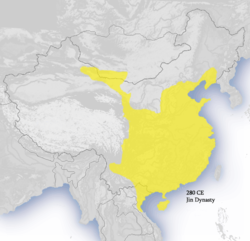Eastern Jin
| The Empire of Jin |
| 晉帝国 |
|
|
|
The Jin Empire (yellow) at its greatest extent, c. 280
(Western Jin)
|
| Capital |
Luoyang (265–311)
Chang'an (312–316)
Jiankang (317–420)
|
| Languages |
Middle Chinese |
| Religion |
Buddhism, Daoism, Confucianism, Chinese folk religion
|
| Government |
Monarchy |
| Emperor |
|
| • |
AD 265–290 |
Emperor Wu of Jin |
| • |
419–420 |
Emperor Gong of Jin |
| History |
|
| • |
Establishment |
265 |
| • |
Reunification of China under Jin rule |
280 |
| • |
Jin evacuates to region south of the Huai River, Eastern Jin begins |
317 |
| • |
Abdication to Liu Song
|
420 |
| Area |
| • |
280 (Western Jin peak) |
3,100,000 km² (1,196,917 sq mi)
|
| • |
347 (Eastern Jin peak) |
2,800,000 km² (1,081,086 sq mi)
|
| Population |
| • |
300 est. |
35,000,000 |
| Currency |
Chinese coin, Cash
|
|
|
| Today part of |
 China China
 Vietnam Vietnam
 Mongolia Mongolia
|
The Jin dynasty, distinguished as the Sima Jin and Liang Jin, was a Chinese dynasty, empire, and era traditionally dated from AD 265 to 420. It was founded by Sima Yan, son of Sima Zhao who was made Prince of Jin and posthumously declared the founder of the dynasty. It followed the Three Kingdoms period (220-280 AD), which ended with the conquest of Eastern Wu by the Jin.
There are two main divisions in the history of the dynasty. The Western Jin (265–316) was established as a successor state to Cao Wei after Sima Yan usurped the throne, and had its capital at Luoyang or Chang'an (modern Xi'an; Western Jin reunited China in 280, but fairly shortly thereafter fell into a succession crisis, civil war, and invasion by the "Five Barbarians." The rebels and invaders began to establish new self-proclaimed states in the Yellow River valley in 304, inaugurating the "Sixteen Kingdoms" era. These states immediately began fighting each other and the Jin Empire, leading to the second division of the dynasty, the Eastern Jin (317–420) when Sima Rui moved the capital to Jiankang (modern Nanjing). The Eastern Jin dynasty was eventually overthrown by the Liu Song.
Under the Wei, who dominated China's Three Kingdoms period, the Sima clan rose to prominence, particularly after the 249 coup d'état at the Gaoping Tombs. Sima Zhao assisted the throne in suppressing other rebellions, recovering Shu and capturing Liu Shan in 263 and opposing Zhong Hui's rebellion the next year. His ambitions for the throne remain proverbial in Chinese but he died before he could rise higher than prince of Jin, a title named for the Zhou-era marchland and duchy around Shaanxi's Jin River. (He was granted the title as his ancestral home was located in Wen County within Jin's former lands.)
...
Wikipedia



